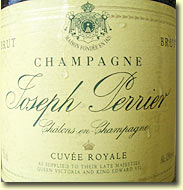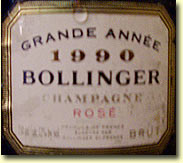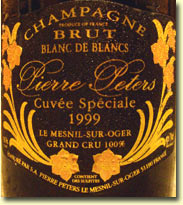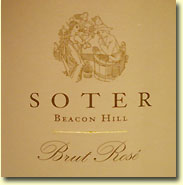But, with a
few hours, everything comes together and this wine starts to drink very
well. Soft and slightly sweet vanilla is poured over baked dark
cherries. A sprinkling of allspice and cinnamon finishes up the dish.
This wine never explodes at you, but instead sneaks up on you and
becomes a very enjoyable foil for pork, turkey, chicken, and salmon
dishes.
I'm not sure if it is because of the first vintage learning curve, the
vintage characteristics, or the wine's age, but the 1997 seems a bit
more subdued and different from the vintages that follow.
Grade of Low B (82-84
pts). Find this wine
1998 Soter Brut Rosé
(70% Chardonnay, 30% Pinot Noir;
Beacon Hill, Yamhill County, Oregon, USA; New & neutral oak along with
stainless steel fermentation and aging; Saignee method; 6-8 g/L dosage;
Disgorged March 2003; 500 cases; $35-50 US)
A cherry and sharp citrus nose explodes up at me from the glass. The
palate follows suit as this wine is wrapped up tight. Not quite ripe red
berries, citrus, and a harsh and jagged finish leave me puckering. But,
as you have probably noticed (or will), this is a recurring theme with
the Soter Brut Rosé. They are tight, jagged, and strange when you first
open them, but let them breathe and they bloom.
About 6 hours later, it dramatically shifted to a
lush, creamy, slightly biscuity, strawberry, and ripe dark cherry
concoction. Touches of allspice, vanilla, and cinnamon rounded it all
out and a mouth-wetting cherry vanilla spiced finish brings it home. Air
can do amazing things to a wine. Grade of Low
B+ (86-88 pts).
Find this wine
1999 Soter Brut Rosé
(65% Chardonnay, 35% Pinot Noir;
Beacon Hill, Yamhill County, Oregon, USA; New & neutral oak along with
stainless steel fermentation and aging; Saignee method; 6-8 g/L dosage;
Disgorged March 2005; 530 cases; $35-50 US)
On opening, a strawberry and cherry spiced nose leads into a palate that
is initially quite off putting. A watered down and slightly astringent
cherry cough syrup flavor mixes with a meaty aspect that left me
scratching my head and wondering what went wrong. The bitter and
slightly harsh finish had me using both hands to do the head scratching.
With a few hours of air, my head scratching stopped and a smile broke
across my face as this had blossomed nicely. What I now had in front of
me was creamy dough wrapped around a filling made of tart citrus,
spiced cherries, and juicy strawberries. A prickly finish was the only
sign of the harsh flavors that initially showed. Grade of High B (85-87 pts). Find this wine
Philipponnat’s Le Reflet is often
referred to as the second wine of Clos de
Goisses because the Pinot from Clos de Goisses that is not
deemed good enough for the “Clos” cuvee is mixed with Chardonnay from
the Cote des Blancs. It performs
best (using “best” in a relative sense) when drunk within 1-2 years of
purchase. Dumb person that I am, I kept the bottle seen below a wee bit
longer.
 NV
Philipponnat Le Reflet
NV
Philipponnat Le Reflet
(50% Chardonnay from the Cote des
Blancs villages of Avize, Chouilly, Cramant, Cuis, Grauves, Oger, &
Vertus, 50% Pinot Noir from Clos des Goisses; ~ 3 years aging on its
lees; I believe this is a pure 1993 disgorged in 1997/1998; $25-45 US)
Lots of honey, citrus, and sherry on the nose are not signaling good
things to me. More sherry, dried out citrus, and thin mineral notes make
up the flavor core. The finish is bitter, thin, and oxidized.
I have gone through multiple bottles of this over the last 5 years. Why
does this fall apart so quickly after release? Philipponnat’s other NV
wines don’t perform like this. I don’t understand, but maybe I shouldn’t
worry, I’m not sure if they make this cuvee anymore and it
was never that good right after release either. Actually, I don’t care
as I’m done with this wine. Grade of D+ (67-69
pts) and over the hill. Find this wine
I am not much of a fan of Michigan wines. I have had quite a few, but at
the end of the day only two hold any place in my cellar. These two are
Wyncroft and
L. Mawby. L. Mawby is a
sparkling wine producer located in the “pinky” of Michigan. L. Mawby
makes quite a few sparkling wines and my favorites sit at the top of his
range. The Blanc de Blancs, Talismon, and Mille have always been welcome
at my table alongside the best of Champagne. L. Mawby is definitely a
producer to watch and I encourage you to pick a bottle up of any of the
three I mention above. I’d wager a hefty sum that the bottle will be
better than you expect and might even have you thinking Champagne with a
twist.
NV L. Mawby Talismon Brut
(A mix of Vignoles, Pinot Noir, Pinot
Gris, and Chardonnay ; Leelanau Peninsula, Michigan, USA; Fermented in
an oak solera system; Cuvee 63; Bottled April 2001; Disgorged December
2004; Bottle 2924 of 3555; $20-30 US)
Gentle kisses of oak laced flowers mix with tart pears and light peaches
to form a rather full bodied and inviting nose. These aromas lead into
flavors of crisp citrus, juicy pear, and creamy oak with delicate
touches of sherry spice. The mouth feel is not quite as full as the nose
would lead you to believe. In fact, the oak and fruit combine to bring
an element of fluffiness to the spicy, citrus filled, and slightly
drying finish.
This wine is quite enjoyable, and in many ways more Champagne-like
than most of what comes out of the US. My only knock on it is that while
I enjoy all of the flavors, they do not integrate together as well as I
would like to see. It is almost like each flavor is singing its own solo
with the oak notes singing especially off key. That said, it is very
enjoyable and a good deal for the price. I will caution that some of L. Mawby’s cuvees can be quite variable in quality. But, at least he notes
the cuvee number and other important information on the bottle so that
you know what you are getting. Grade of Low B
(82-85 pts). Find this wine
 NV
Joseph Perrier Cuvee Royale
NV
Joseph Perrier Cuvee Royale
(35% Chardonnay, 35% Pinot Noir, 30%
Pinot Meunier; Reserve wines aged in large, old oak barrels; Disgorged
~2002; $30-40 US)
A somewhat rich nose boasting doughy biscuits, pears, steely & floral
citrus, and a very slight hint of nutty maturity greets me and brings a
smile to my face. The palate has a good body and a striking citrus
backbone that shows hints of sherry and knocks me back a bit with its
power. Branching off from the backbone are flavors of pear, biscuit
dough, yeast, hints of salt and a chalky minerality. It finishes up
rather long with a creamy chalky note that darts off in racy directions
every now and then.
This is quite a wild wine. It is very flavorful, but many of the flavors
are raw and jagged. It is not a soft or delicate NV wine, but rather it
is one that calls out for food. Be it roasted chicken, turkey, or a nice
piece of beef, this wine will be at home. I for one enjoy the wild-eyed
personality that it shows. It will age for a good deal longer and is
guaranteed to break you out of any stupor you may be in.
Grade of Solid B (84-86 pts). Find this wine
 2004
Canals Nadal Cava Brut
2004
Canals Nadal Cava Brut
(45% Xarel-lo; 40% Macabeu, 15%
Parellada; 2 years aging on the lees; alc; $10-15 US)
Light and fluffy aromas of pear, yellow apples, citrus, and baseball
card bubble gum powder fill my nose. The palate starts off with a rush
of citrus, but quickly becomes more Cava like as a light to medium
fluffy body is highlighted by gently tart apples and pears. A bubble gum
tinged creaminess finishes it out.
Normally I find bubble gum flavors to be a turn off, but they are in the
background of this Cava and are nicely integrated. I am impressed by
this bottle of bubbles. It isn’t very expensive, it is very refreshing,
and the flavors all play nice. This won’t knock you out, but it will
bring a smile to your face. I like it quite a bit more than the
2003 Reserva.
Grade of High B- (81-83 pts). Find this wine
 NV
Costco Kirkland Signature Brut Rosé
NV
Costco Kirkland Signature Brut Rosé
(30% Chardonnay, 50% Pinot Noir, 20%
Pinot Meunier; Produced by SAS Jannison for de Bruyne who packaged this
for Costco; Some oak fermentation/aging; Disgorged 2006; $30 US)
You have to love Costco. According to the front label this wine is
“rare.” The back label tells us that this wine is from
Sezanne and that Rosé Champagne is now
“very rare” as Rosé Champagne represents only a miniscule portion of
Champagne produced (amazing how Rosé Champagne grew more rare in the
time it took me to spin the bottle around). I guess everything is
relative, but when the local party store has a couple different Rosés,
they sure aren’t rare. Oh, and this wine isn’t from Sezanne either
(though parts of it may be). Sezanne just happens to be the headquarters
for the Champagne Negociant Distributeur de
Bruyne who participated in getting Costco’s name on the
label.
As for the wine, it has a cloying, copper tinged pink color to it. I
call it cloying because the color tilts towards a pastel hot pink and
just doesn’t sit right with me. That may sound strange and I can
overlook it, but I just don’t like it as it seems that it was concocted
based on the results of a marketing research study. The nose has a nice
upfront aroma of bright red citrus fruits, but they are quickly
overtaken by dusty biscuit notes that dry everything up. A very lively
palate greets me with bursts of tart ruby red grapefruit, creamy sweet
biscuits, a bit of chalk dust, and juicy red berries. It is definitely
quite flavorful, but the finish knocks it back a bit with its dried out
hard dough notes.
This wine is a bit of a handful. On one hand, it is a bit too tart and a
bit too sweet. It is a bit cloying and has similarities to SweetTarts ™
candy. It also has an odd hard and dry finish to it. On the other hand,
it is quite flavorful and it is a bit young so with time the faults may
work themselves out. In the end, I find this very similar to Costco’s
Brut Champagne (also made by Jannison). It is a bit rough out of the
gate, but has the potential to improve. It isn’t a great find, but it
performs as expected for the price. Grade of
High C+ for today (78-80 pts) with B- potential (80-82 pts) in 1-3
years.
2004 Roessler La Brisa Sonoma Coast Peay Vineyard Pinot Noir
(100% Pinot Noir; Sonoma Coast,
California; 14.8% alc; 97 cases; $35-50 US)
This is what I call a Tony Klee Selection.
Tony is the wine guy at Holiday Market in Canton, MI and is always quick
to point out a top-notch wine that he thinks is well priced and tailored
for my palate. He is a big fan of US Pinot and has the knack at finding
small production gems and also finding a way to offer them at reasonable
prices. This Roessler was one of his new finds and I happily scooped a
bottle up to try.
In the glass, it takes on a slightly dark cherry hue. Mix this with the
lush and deep cherry and spice aromatics and you have the makings of a
rich pinot that appears to perfectly balance big and ripe with elegance
and finesse. Flavors of ripe cherry, cinnamon, allspice, a touch of
horsehide, some tartness, and tea leaves paint a very expressive palate.
A well-structured finish brings out more of the tea notes and gives a
hint that the next few years will be kind to this wine.
I’ve never been known as a Pinot Noir fan, but I enjoyed this wine very
much. It shows good fruit, but has plenty of other flavor complexity as
well as a tannic streak to ring in the future. The alcohol percentage is
on the high side for Pinot in my book, but I never picked up on any
heat. Good pick Tony; I would gladly buy this again. And, this is a
still wine and not a bubbly. Not all the wines I drink have bubbles, but
if I write one up here, it moved me. Grade of
High B+ (88-90 pts). Find this wine
NV Jacques Selosse Brut Rosé
(90% Chardonnay, 10% Pinot Noir; Oak
fermentation and aging; $125-225 US)
Well, I love Jacques Selosse’s
wines, but he needs to stick to Chardonnay because all adding Pinot Noir
does to this cuvee is ruin it. It carries the trademark of Selosse,
being rich with attractive sherry and oak notes and hints of spiced
cream. Unfortunately, these flavors (which come from the
Chardonnay) do not go well with the Pinot Noir. Where Selosse’s Blanc de
Blancs would keep on climbing the ladder to flavor paradise, the Pinot
Noir brings in an odd cherry note that knocks you off the ladder. It is
interesting, but the Chardonnay and Pinot Noir fight with each other and
create a wine that absolutely does not go with food. It isn’t a bad
wine, but it is one to drink without food. In a way, it is kind of like
a Mollydooker or
Marquis Philips Shiraz in that it is
interesting to have a glass, but what do you do with a bottle?
Grade of Low B (82-84 pts). Find this wine
 1990
Bollinger Grande Annee Rosé
1990
Bollinger Grande Annee Rosé
(71% Pinot Noir, 29% Chardonnay; Red
wine addition method; Disgorged late 1990s; $100-150 US)
I’ve had this wine a few times in the past and it has been all over the
place in quality. This is to be expected as Bollinger had documented
quality problems with it. Luckily, this one didn’t show any ill
effects and was a rather good example of what Bollinger could do with
Rosé in 1990. However, I should also mention that Bollinger has never
fared well with their Rosés (though they reportedly made some changes in
1996 and have produced nice ones since then) so “good example” should
be taken in relative terms.
A rich and biscuity nose greets me with a smile, but this wine must not
like me too much as the palate quickly turns that smile to a frown.
There is plenty of dark toast and coffee grind flavors, but a few
off-putting sherried red berry notes muddle the picture. Others
commented that they found dark chocolate flavors in the wine and I can
see that, but I can’t find much fruit and that worries me. It does
improve with food, but it leaves me wanting something else.
Grade of High B- (81-83 pts). Find this wine
 1999
Pierre Peters Cuvee Speciale Blanc de Blancs
1999
Pierre Peters Cuvee Speciale Blanc de Blancs
(100% Chardonnay; Le Mesnil-sur-Oger;
70+ year old vines from a single parcel called Chetillons Stainless
steel fermentation; 7-8 g/L dosage; Disgorged early 2006; $65-90 US)
A nose full of creamy pears, mellow apples, dough, and hints of funk
greets me. I’m not sure where the funk is coming from, but it recalls
1980’s vintage Salon. The palate shows more of the funk as it meshes
with citrus and yeast to form a somewhat racy and large tasting
beginning. Steely and mineral laced lemons and apples follow up the
funky citrus and lighten the wine up, but then this does a
Demon Drop. Out of nowhere this wine disappears clean as a
whistle as a whiff of fresh linen, apple juice, and mineral dashes off
before you realize that it was leaving.
Well, this is certainly an interesting wine. It has many good points,
but it just doesn’t seem to put it all together. I fell in love with the
Cuvee Speciale in the 1996 vintage, but further vintages have failed to
deliver the hype this cuvee gets. With time this will improve a bit, but
I still think I would rather have a bottle of the NV Cuvee de Reserve at
around half to two-thirds the price. Grade of
Low B (82-85 pts) with Low B+ (86-88 pts) potential in 5-10 years. Find this wine
Cheers!
Brad Baker
BACK TO THE TOP
BACK TO BRAD BAKER'S
INDEX PAGE
June 2007 © Brad Baker


 2001
Soter Beacon Hill Brut Rosé
2001
Soter Beacon Hill Brut Rosé NV
Philipponnat Le Reflet
NV
Philipponnat Le Reflet NV
Joseph Perrier Cuvee Royale
NV
Joseph Perrier Cuvee Royale 2004
Canals Nadal Cava Brut
2004
Canals Nadal Cava Brut NV
Costco Kirkland Signature Brut Rosé
NV
Costco Kirkland Signature Brut Rosé 1990
Bollinger Grande Annee Rosé
1990
Bollinger Grande Annee Rosé 1999
Pierre Peters Cuvee Speciale Blanc de Blancs
1999
Pierre Peters Cuvee Speciale Blanc de Blancs